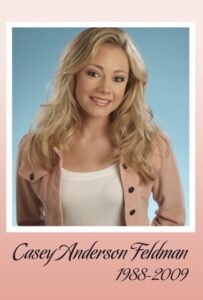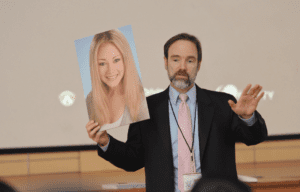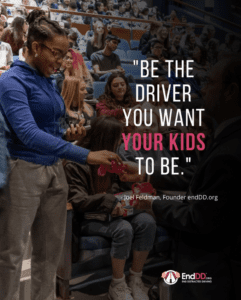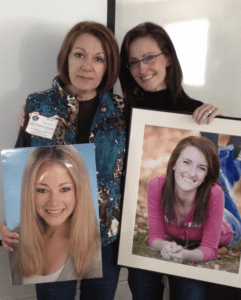EndDD.org is fighting distracted driving through education, advocacy, and action

Casey Feldman was a 21-year-old student headed into her senior year at Fordham in 2009. She was the editor of her school’s newspaper and about to become a journalist after graduation. On a summer day in 2009, her life was cut short. Casey was killed by a distracted driver.
After losing their only daughter, Casey’s parents, Joel Feldman, and Dianne Anderson founded the Casey Feldman Foundation and EndDD.org. The mission of EndDD.org is to educate students about distracted driving so that they can change the driving culture and make distracted driving socially unacceptable.
EndDD.org works with schools, community organizations, and businesses to educate people about the risks of distracted driving and to encourage them to make safe choices behind the wheel.
We caught up with Joel to hear how EndDD.org’s science-based education programs are effective in changing behavior and promoting safe driving practices, with a particular focus on young people.
Our conversation has been edited for clarity and brevity.
CMT: Hi Joel. Thank you for speaking with CMT today. To start, can you share your story with us?
Joel: In July of 2009, my 21-year-old daughter Casey was crossing the street in a crosswalk on the way to her summer job on the Ocean City boardwalk. As she was crossing, a 58-year-old man chose to take his eyes off the road and reach for his GPS. He rolled through a stop sign, hit Casey, and said that he never saw her. We got the call to go to the hospital and a couple of hours later the surgeons came into the room. They didn’t even have to say anything. We looked at their faces and we knew that Casey was dead.
 Within a couple of weeks, my wife and I committed to doing everything we could to reduce distracted driving crashes. We particularly want to protect kids who have their lives in front of them. We knew we had to do something about that.
Within a couple of weeks, my wife and I committed to doing everything we could to reduce distracted driving crashes. We particularly want to protect kids who have their lives in front of them. We knew we had to do something about that.
And that’s what we did. We started the foundation which is the legal entity, the Casey Feldman Foundation, a 501C3 nonprofit, and a campaign called EndDD.org, which stands for End Distracted Driving.org. My wife does a lot of the foundation work which focuses on scholarships for students who want to do public service work and sponsoring students.
CMT: What is the mission of the Casey Feldman Foundation?
Joel: The Casey Feldman Foundation supports charitable, educational, and literary pursuits and encourages volunteerism and good citizenship through the award of scholarships and gifts. We empower future philanthropic leaders with over 135 scholarships and stipends, including college scholarships for high school seniors, internships for journalism and public service, and alternative spring break scholarships for community service.
We also are very proud to have created the Casey Feldman Transportation Safety Reporting Award. Casey was about to become a journalist. She was going to be a senior at Fordham and was the editor of the school newspaper. While distracted driving wasn’t Casey’s issue, investigative journalism was, and this year’s winning entries were great pieces of reporting. The winning entries focused on pedestrian safety and have prompted municipalities to explore safety improvements.
CMT: What is the mission of EndDD.org?

Joel: EndDD.org’s mission is to prevent crashes caused by distracted driving and to promote safe driving practices through education, advocacy, and action. We create science-based education programs that will reach people and will get them to do two things; stop driving distracted and speak up when they see other people drive distracted.
Our mission is to change the culture surrounding distracted driving because right now it’s too acceptable. How do you drive that culture change? Well, you drive it with young people.
We do most of our work with high school students and college students. Two years ago we released our elementary school distracted driving lesson plans and we have a K-2 distracted driving picture book, Sam’s Trip to the Beach.” Both of these projects are really taking off. Our goal is to create a generation of kids who won’t drive distracted when they get their licenses.
We have speakers all across the country who are lawyers like me, who volunteer their time to go into these schools and speak. We recently presented to our 510,000th student and are working in 48 states.
These presentations are free and we have training videos to walk our speakers and volunteers through the presentation to teach them so they can teach students.

CMT: What challenges do you face when teaching people about distracted driving?
Joel: The challenge is the attitude people have towards distracted driving. Most people think it’s okay if they do it but if they saw someone in the car next to them doing it, they would get all bent out of shape about it. That’s part of what we work on. We work on the psychological and emotional side to try to get people to look beyond whether or not it’s dangerous.
The traditional excuses we hear from people are “I can handle it, I’m a safe driver, I’ve never been in a crash, I know how to multitask, it’s just a few seconds, etc.” Actually, the man who killed Casey was reported to have told the police, “I only looked away for a few seconds.”
If you think about it, every one of those excuses has thousands of deaths attached to them. Whatever excuse you can think of, I know a family who is suffering because of that excuse.
CMT: What is on your wishlist for the next 12-18 months for road safety?
Joel: Well, I’m optimistic. I’m optimistic that we are getting kids to change their behaviors, their friend’s behaviors, and mom and dad’s behaviors. I am optimistic that they are driving that culture change.
We’ve funded the beginning of a project with Harvard that studies teens and focus groups to figure out what messages best resonate with them to put their phones down and get them to speak up. I am hoping to produce those messages into PSAs to speak to kids.
I have a couple of grant requests for the elementary schools’ distracted driving program in different states, different organizations,

and safety offices to see if they will help us get that into schools. We’ve had success with it so far, just not enough schools. We need help to get into schools.
Many studies show if you have a mom or dad that drives distracted, you’re almost three times as likely to drive distracted as someone who doesn’t. We’re modeling the worst kind of behavior when it comes to traffic safety. More needs to be done when it comes to parents’ dangerous driving behaviors.
Studies show and we teach this, kids have incredible power to change behaviors. 90% of kids say they would put their phone down if their friend asks them to. One of the strongest deterrents for parents to not drive distracted is if their kids ask them not to do so.
CMT: What is something people can do now to fight distraction?
Joel: The simplest and easiest solution is to use the “Do Not Disturb” feature on your phone. If you hear the notification in all likelihood you’re going to grab your phone. That’s the reality. If you don’t hear it, you won’t reach for it. It’s that simple.
Another great thing to look into is the part that CMT does. Giving that real-time feedback to people, whether it’s to get a discount on their insurance policy or change their driving behaviors in a contest with the Safest Driver app, is so important. A marriage of education and tech will help us get out of the problem that was created by tech in the first place. Safest Driver and CMT’s apps with insurers are incredibly valuable in this fight.